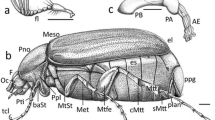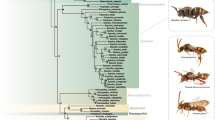Abstract
Relationships among the species of Exaerete Hoffmannsegg (Apinae: Euglossini) were explored based on new morphological data and including new taxa described since the study of Engel (Am. Mus. Novit. 3272, 1–14, 1999). Analysis of the data matrix was undertaken in NONA using the WinClada interface and resulted in a single topology of length 39, CI 0.66, RI 0.78. Three principal clades were identified in the genus, resulting in interrelationships among the species as: (((E. smaragdina + (E. frontalis + E. lepeletieri)) + ((E. trochanterica + E. guaykuru) + (E. azteca + E. dentata))). Biogeographic patterns are briefly discussed in light of the recovered phylogeny and Exaerete lepeletieri Oliveira & Nemésio is newly considered a synonym of E. frontalis (Guérin-Méneville).
Zusammenfassung
Die kleptoparasitische Pracht-bienengattung Exaerete Hoffmannsegg (Apinae: Euglossini) umfasst 7 Arten (Abb. 1) die sich andere Gruppen der Prachtbienen zum Opfer machen. Die evolutionären Beziehungen zwischen den 7 Arten wurden anhand von Daten über die externe Morphologie adulter Bienen untersucht. Eine frühere Studie von Engel (1999) wurde um mehrere neue für eine phylogenetische Analyse nutzbare morphologische Eigenschaften erweitert und darüber hinaus die seit 1999 neu beschriebenen Arten einbezogen. Unter Benutzung von NONA wurde eine parsimonische Analyse durchgeführt, die zu einer einzigen Topologie führte. Innerhalb des Genus wurden drei Hauptgruppen der Arten identifiziert. Die Beziehungen zwischen den Arten können folgendermassen zusammengefasst werden: ((E. smaragdina + (E. frontalis + E. lepeletieri)) + ((E. trochanterica + E. guaykuru) + (E. azteca + E. dentata))) (Abb. 2). Die Gattung besiedelt einen geografischen Bereich von Argentinien bis Mexico, wobei einige Arten in der neotropischen Region weit verbreitet sind. Nur wenige biogeografische Muster sind als solche erkennbar, aber es scheint dass die Gattung ihren Ursprung in Südamerika genommen hat, mit lokalisierten Arealen einer Artbildung in Mexico (for E. azteca) und Brasilien (for E. guaykuru). Aus den wenigen zur Verfügung stehenden Daten zur Biologie von Exaerete konnte kein Muster der Wirtspreferenz abgeleitet werden. Exaerete lepeletieri Oliveira & Nemésio wird neu als ein Synonym von E. frontalis (Guérin-Méneville) angesehen.
Similar content being viewed by others
References
Anjos-Silva E.J. dos, Rebêlo J.J.M. (2006) A new species of Exaerete Hoffmannsegg (Hymenoptera: Apidae: Euglossini) from Brazil, Zootaxa 1105, 27–35.
Anjos-Silva E.J. dos, Camillo E., Garófalo C.A. (2006) Occurrence of Aglae caerulea Lepeletier & Serville (Hymenoptera: Apidae: Euglossini) in the Parque Nacional da Chapada dos Guimarães, Mato Grosso State, Brazil, Neotrop. Entomol. 35, 868–870.
Bennet F.D. (1972) Observations on Exaerete spp. and their hosts Eulaema terminata and Euplusia surinamensis (Hymen., Apidae, Euglossinae) in Trinidad, J. N. Y. Entomol. Soc. 80, 118–124.
Engel M.S. (1999) The first fossil Euglossa and phylogeny of the orchid bees (Hymenoptera: Apidae; Euglossini), Am. Mus. Novit. 3272, 1–14.
Engel M.S. (2004) Fideliine phylogeny and classification revisited (Hymenoptera: Megachilidae), J. Kans. Entomol. Soc. 77, 821–836.
Garófalo C.A., Rozen J.G. Jr. (2001) Parasitic behavior of Exaerete smaragdina with descriptions of its mature oocyte and larval instars (Hymenoptera: Apidae: Euglossini), Am. Mus. Novit. 3349, 1–26.
Goloboff P.A. (1997) NoName (NONA), version 2.0. Program and documentation. Fundación y Instituto Miguel Lillo; Tucumán, Argentina [online] http://www.cladistics.com (accessed on 19 April 2007).
Moure J.S. (1964) A key to the cleptoparasitic euglossine bees and a new species of Exaerete from Mexico (Hymenoptera Apoidea), Rev. Biol. Trop. 12, 15–18.
Nixon K.C. (2002) WinClada, version 1.00.08. Program and documentation, Cornell University, Ithaca, New York, [online] http://www.cladistics.com (accessed on 19 April 2007).
Nixon K.C., Carpenter J.M. (1993) On outgroups, Cladistics 9, 413–426.
Oliveira, M.L., Nemésio A. (2003) Exaerete lepeletieri (Hymenoptera: Apidae: Apini: Euglossina): A new cleptoparasitic bee from Amazonia, Lundiana 4, 117–120.
Pereira-Martins S.R. (1991) Biologia de Eulaema nigrita. 2. Atividades nidais, Pap. Avulsos Dep. Zool., São Paulo 37, 237–243.
Zucchi R., Sakagami S.F., Camargo J.M.F. (1969) Biological observations on a neotropical parasocial bee Eulaema nigrita, with a review on the biology of Euglossinae (Hymenoptera: Apoidea): A comparative study, J. Fac. Sci., Hokkaido Univ. (Ser. VI: Zool.) 17, 271–380.
Author information
Authors and Affiliations
Corresponding author
Additional information
Manuscrit editor: Walter S. Sheppard
Rights and permissions
About this article
Cite this article
dos Anjos-Silva, E.J., Engel, M.S. & Andena, S.R. Phylogeny of the cleptoparasitic bee genus Exaerete (Hymenoptera: Apidae). Apidologie 38, 419–425 (2007). https://doi.org/10.1051/apido:2007023
Received:
Revised:
Accepted:
Issue Date:
DOI: https://doi.org/10.1051/apido:2007023




